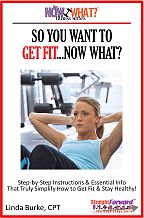Buy "The Now What? eBooks" Here! Or go to Smashwords for misc. formats.
The Now What Fitness Series lays out the foundation of fitness in a concise and simplified manner, making for a collection of books that help the reader truly comprehend how to improve one's health and well-being from A to Z. I've broken fitness down into comprehensive concepts, giving anybody who truly wants to change their health and their lives in profound ways, the step-by-step tools and knowledge to do so.
Getting in the Target Heart Rate Zone
What's all this fuss about target heart rate, you ask?
Well, we know to improve our cardiovascular endurance we must perform cardio/aerobic exercise, right? But there is a little more to it than that. We need to get our heart rate up into the desired target heart rate zone for a sustained period of time in order to utilize the overload principle and to lead to substantial fitness improvements over time.
ACSM (American College of Sports Medicine) says we need moderate-intensity exercise (40-60% of HRR) for at least 30 minutes on 5 or more days a week, for a total of 150 minutes per week, or vigorous-intensity exercise (60-85% of HRR) for at least 20-25 minutes on 3 or more days a week for a total of 75 minutes per week. For weight loss, 50-60 minutes per day to a total of 300 minutes moderate exercise is recommended.
WHAT IS YOUR OPTIMUM EXERCISE INTENSITY?
Studies show that optimum exercise intensity for fitness improvement is in the range of about40% to 85% of (HRR) heart rate reserve. Of course, the fitter you are, the higher the appropriate exercise intensity. Very deconditioned individuals may begin to improve at about 30%-40% of HRR.
***HERE IS AN ISSUE THAT CALLS FOR SOME SIFTING OF FACTS FROM FICTION, OR AT THE VERY LEAST, POINTING OUT UNRELIABLE DATA.***
Below is the popular Target Heart Rate chart seen in most gyms across America. I suggest you use it in conjunction with other ways of measuring intensities too, just to be safer and closer to accurate.
Average Target Heart Rate Chart Found in Most Gyms
| Age | Target HR Zone 50–85% | Average Maximum Heart Rate 100% |
| 20 years old | 100–170 beats per minute | 200 beats per minute |
| 25 years old | 98–166 beats per minute | 195 beats per minute |
| 30 years old | 95–162 beats per minute | 190 beats per minute |
| 35 years old | 93–157 beats per minute | 185 beats per minute |
| 40 years old | 90–153 beats per minute | 180 beats per minute |
| 45 years old | 88–149 beats per minute | 175 beats per minute |
| 50 years old | 85–145 beats per minute | 170 beats per minute |
| 55 years old | 83–140 beats per minute | 165 beats per minute |
| 60 years old | 80–136 beats per minute | 160 beats per minute |
| 65 years old | 78–132 beats per minute | 155 beats per minute |
| 70 years old | 75–128 beats per minute | 150 beats per minute |
This theory surmises that your maximum heart rate is about 220 minus your age. However, this chart is only accurate for about 75% of the population. This limitation can be overcome, to some extent, by combining the HRR (heart rate reserve) method with the RPE (ratings of perceived exertion) method, which I explain more the RPE section below.
The HRR method or the Karvonen Method factors in your resting heart rate, therefore, helps alleviate the margin of error a bit also. The actual equation for the HRR, then, is
220 - age = estimated max heart rate
Estimated max HR - resting heart rate = HRR
HRR x percentage = percentage of HRR
Percent of HRR + resting heart rate = target HR
Of course you need a range, so let's say you you are a 40-year-old with a resting heart rate of 70 bpm who wants to train at a vigorous pace of 60-85% of your HRR.
220 - 40 = 180
180 - 70 = 110
110 x .60 = 66 (60%)
110 x .85 = 94 (85%)
66 + 70 = 136
94 + 70 = 164.
Therefore your target heart rate zone for working at a vigorous intensity using the HRR method would be 136-164 bpm. If you want a 10-second count you can divide that by 6 which would give you the range of 23-27.
Note: Some high blood pressure medications lower the maximum heart rate and thus the target zone rate. If you're taking such meds, call your doctor to see if you need to use a lower target heart rate.
BIG HONKIN' NEWS FLASH: There is a great deal of controversy over the 220-minus-age theory. Here it is in a nutshell: It overestimates the maximum rate in young adults, does a pretty good job for people who are around 40 years old, and then increasingly underestimates the maximum rate as people get older.
Apparently, it can be off by as much as 30 beats or so. And get this, the guy who invented it didn't EVEN mean for it to become the "LAW" of max heart rates. To read the real facts about this issue, click here. It is a very short and enlightening article and well worth the read.
MORAL OF THIS STORY: Use caution when using age group average maximal heart-rate tables and the 220-minus-age formula for the aforementioned reasons.
BIG HONKIN' QUESTION: So, how do we know what our heart rate max is, and once we know what we are aiming for, what is the best way to measure it, you ask?
Go from Target Heart Rate to Cardiovascular Fitness
Go from Target Heart Rate to Straightforward Fitness Home Page
